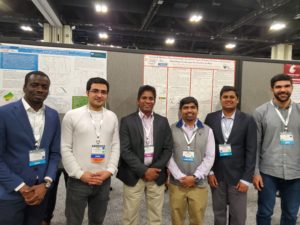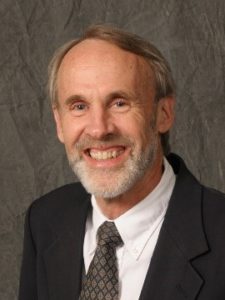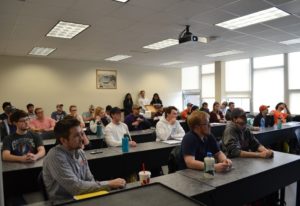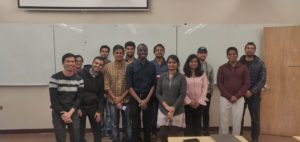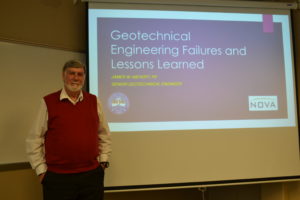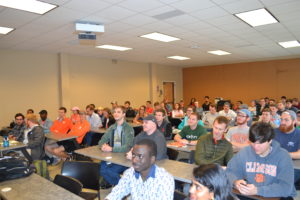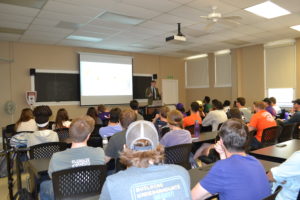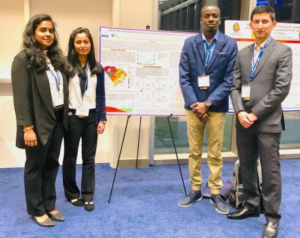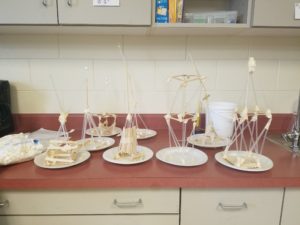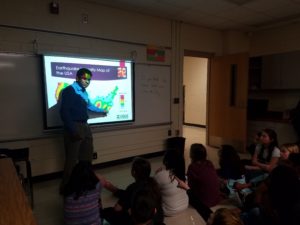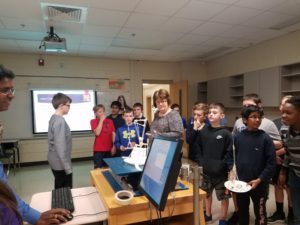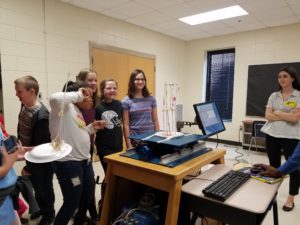March 20-23, 2022: GeoCongress 2022
Clemson GI-GSO members presented 5 papers (1 oral and 4 poster presentations) at the GeoCongress 2022.
March 14, 2022: Cross USA Lecture by Mr. Silas Nichols
October 27, 2021: Professional Talk by Dr. Daghash, Ph.D., P.E.
Title: Load Rating of Arch Bridges Using CANDE Software
CANDE [Culvert ANalysis and Design] software is a special purpose 2D finite element computer program developed for the structural analysis and design of soil bridges, buried culverts and underground structures. CANDE is applicable to all cross-sectional shapes and materials including corrugated metal, reinforced concrete, and thermoplastics. This presentation will provide a summary of the guidance and direction for using CANDE software and CANDE Toolbox with regards to performing the load rating of arch bridges. The presentation will show the process of major input options available in CANDE through modeling and load rating of one concrete arch bridge and showing the results.
Dr. Daghash is a Structural Engineer at Michael Baker International in Virginia Beach, VA. He has experience in steel and concrete bridge repair, bridge new designs, and load rating of girder bridges, culverts, and arch bridges. He has also performed the structural design of multiple water and wastewater pump stations and other civil facilities. After graduating in 2009 with a Bachelor’s degree in structural engineering, Dr. Daghash worked for three years as a Structural Design Engineer designing high-rise concrete residential buildings performing wind and seismic analyses. He then received his Master’s degree in 2013 from the University of New Mexico working on modifying epoxy polymer concrete and FRP with Carbon Nano-tubes (CNTs) to enhance their impact and fatigue properties. In 2018, Dr. Daghash received his Ph.D. from the University of Virginia studying the applications of innovative materials, such as Shape Memory Alloys (SMAs) and corrosion-resistant Steel (A1010), in civil engineering. Dr. Daghash has published a total of 31 journal and conference papers on different applications in Structural Engineering.
September 22, 2021: Professional Talk by Mr. Bennett Livingston, P.E.
Title: Earth Retention in the Construction Industry
Wurster Engineering and Construction, Inc. (WEC) is a local geotechnical specialty contractor who works in the southeast United States. WEC specializes in the design and construction of several earth retention systems discussed in the Clemson University Earth Slope and Retaining Structures class. The purpose of this presentation is to explain how WEC approaches a project using slope stability principles, elaborate on the installation of several earth retention systems, and present two case studies in the local area. Earth retention is commonly needed for below-grade construction when laying back the soil to an acceptable slope ratio cannot be achieved due to site constraints. Less common reasons are for landslide remediation. These problems are solved by a design-build approach. WEC engineers have to understand the principles of slope failures, construction processes, and utilize slope stability software to engineer and construct a solution for the general contractor or owner. Typical methods used in the Upstate such as soil nails, tiebacks, and soldier pile walls will be discussed. WEC has used these methods to provide excavation support at the Clemson Shepherd Hotel project and to repair a 300 ft. long deep-seated landslide on Lake Keowee for three homeowners.
Bennett was born and raised in Eastern North Carolina but has made the Upstate his home for the last 6 years. He is now a project manager for Wurster Engineering & Construction, Inc (WEC). Bennett’s focus at WEC is earth retention projects and deep foundation projects in South Carolina, Georgia, and occasionally North Carolina. At WEC he wears many hats to provide excellence to clients by also performing estimation services, engineering design, and periodically field engineering.
April 14, 2021: Professional Talk by Mr. Doug Chappell
Doug Chappell currently serves as vice president of Wurster Engineering & Construction Inc. Mr Chappell has a degree in mining engineering from the University of Missouri at Rolla. Prior to working with Wurster he worked as an engineer in mines in North and South America, as well as serving as engineering manager for a regional geotechnical consulting firm. Mr Chappell is currently responsible for engineering and project management for Wurster and has designed and managed hundreds of Geotechnical construction and ground improvement projects in the southeast
Match 24, 2021: Professional Talk by Mr. Josh Gathro
The presentation focused on geotechnical investigations and engineering analyses for Piedmont geology. The upstate of South Carolina primarily consists of residual soils which often behave differently than coastal soils, for which many traditional geotechnical analyses were developed. This presentation offered a glimpse of typical geotechnical considerations important for bridges, industrial and commercial developments, and soil and rock slopes.
Mr. Gathro graduated with my Master’s Degree from Clemson University in 2018 and began working for S&ME, Inc. in Greenville, SC.
September 25, 2019: Professional Talk by Dr. Robert C. Bachus, P.E., D.GE from Geosyntec Consultants on Performance of High-Strength Geogrid in the Reinforced Soil Slope at the Yeager Airport
Dr. Bachus is a civil engineer with more than 40 years of experience, with expertise in Geotechnical and Geoenvironmental Engineering. He is a Senior Principal at Geosyntec Consultants, an Adjunct Professor at Georgia Tech, and Chairman of the Transportation Research Board’s Standing Committee on Soil and Rock Properties.
The talk focused on a case study where the performance of high-strength geogrid in a 74-m tall, 1 horizontal to 1 vertical (1H:1V) reinforced soil slope (RSS) was discussed. The RSS was constructed for the extension of Runway 5 at the Yeager Airport in Charleston, WV, portions of which had failed nearly 8 years after its construction. A forensic investigation was done on the exhumed samples of geogrids. Results indicated that there was only relatively minor strength loss in the geogrid despite nearly eight years of service in contact with the aggressive (i.e., large particle size) backfill soils. This led to the conclusion that these types of reinforcement products performed extremely well after nearly eight years of service in an aggressive backfill.
March 7, 2020: Shake Table Demonstration to High Schoolers
The GI-GSO partook in the High School convention held on Clemson University campus to introduce the high schoolers to the various facets of civil engineering. Since the focus of our organization is geotechnical engineering, we made it a point to demonstrate a geotechnical phenomenon that emphasizes the importance of that branch of civil engineering. It is called Shake Table Demonstration. At the end of the demonstration, the high schoolers were fascinated by observing how reinforcing deep foundations in saturated soils can reduce the chances of collapse of buildings during earthquake.
March 4, 2020: Professional Talk by Mr. Doug Chappel, P.E., Vice President of Wuster Engineering and Construction Inc., on Deep Foundations and Ground Improvements
Promotional Summary: “From Borings to Buildings” Case studies in design-build deep foundations and ground improvement for projects in the Carolinas. Particular emphasis on the intersection of site characterization and the design-build process.
December 6, 2019: Annual Exhibition and Get-together
The maiden annual exhibition and get-together was done to create the opportunity to publicize the organization in the department and keep the attendees abreast of the activities that are undertaken by the organization. Though last year’s was the first of its kind, it saw good attendance from the graduates in the department.
November 18, 2019: Professional Talk by Mr. James W, Niehoff, P.E. from NOVA on Common Geotechnical Failures and their Remedies
Excessive settlement of both low and high-rise buildings, the partial collapse of a building due to inadequate excavation bracing, the formation of a large sinkhole caused by a damaged sewer line, a retaining wall failure, and a massive crane collapse, among others. For each case history, the cause or causes of the failure are examined and lessons learned from each failure are discussed.
October 4, 2019: Professional Talk by Mr. Tyler Moody, P.E. from BLE on Slope Stabilization Techniques for Common Types of Slope Distress
Properly designed earth and waste slopes should not experience distress. However, unexpected loads, pore pressures, and soft materials can lead to serviceability problems or complete slope failure. Slope stabilization techniques for common types of slope distress will be discussed and a case study will be reviewed.
April 10, 2019: Professional Talk by Mr. William M. Camp, III, P.E., D.GE. from S&ME on Piles in Moving Ground: Pile-Induced Soil Movement and Soil-Induced Pile Movement
William M. Camp delivered a technical presentation on 10th April 2019. Mr.Billy is the Vice President and Technical Principal at S&ME. At S&ME, Mr. Camp serves as an internal consultant to geotechnical staff. He serves on the Geo-Institute’s (GI) Deep Foundations Committee, the DFI Ground Improvement Committee, the PDCA Technical Committee, and the ASCE Standards Committee on the Seismic Design of Piers and Wharves. He is a former President of the Geo-Institute.
The talk was mainly focused on the Pile-induced Soil Movements and Soil-induced Pile Movements. Pile installation can produce soil displacements with unanticipated consequences. Similarly, unexpected soil movements can impose problematic loads on piles. Two Case histories of driven piles were explained to illustrate when these issues may occur and what can be used to prevent/mitigate the problems.
March 24-27, 2019: GeoCongress 2019 Conference Presentations
One of the graduate student members of ASCE GI-GSO at Clemson University attended Geo-Congress 2019 conference at the Pennsylvania Convention Center, PA which held from March 24-27, 2019. The student presented the papers titled, “Comparison of Settlement Response of Piled-Raft Foundation Subjected to Combined Loads Computed from Finite Element and Analytical Models” during a technical session and “A Procedure for Incorporating Climatic and Water Table Data in the Geotechnical Design of Driven Pile Subjected to Axial Load” during a poster session. In addition, our member also attended the Student Leadership Council (SLC) meeting during the conference as an SLC representative of ASCE GI-GSO at Clemson University.

March 4-5, 2019: GeoCarolinas 2019 Conference Poster Presentations
The ASCE GI-GSO members at Clemson University participated in the second GeoCarolinas Conference by organized by the Carolinas Chapter of the Geo-Institute. The conference was held at the University of North Carolina Charlotte Center City from 4th to 5th of March 2019. As the name suggests, the participants at GeoCarolinas included geotechnical professional from South Carolina and North Carolina. There were twelve speakers and eighteen exhibitors from academia and industry. This edition of the conference was nothing less than interesting, enlightening, insightful, and fun as it included a forty-five-minute student poster session from Clemson University, NC State, UNC Charlotte, USC, NC A&T, and the Citadel. Four of our GI-GSO members were privileged to be among twenty-two students to receive travel grants to partake in the conference. The following are the research topics presented by the GI-GSO members at Clemson University during the student poster session: 1) Developing a Shear Wave Velocity Model for the state of South Carolina for Earthquake Hazard Assessment, 2) Robust Design and Optimization Methodology for Piled-Raft Foundation for Tall Wind Turbine in Clayey and Sandy Soils, 3) Analysis of Piled-Raft Foundation using Analytical and Numerical Methods and Development of New Foundation Through Biomimicry, 4) Coupled Hydrological-Geotechnical Model for Determining Performance of Foundations, and 5) Analytical and Numerical Investigation of Effectiveness of Ground Modification Around Pile-Raft for Tall Wind Turbine in Weak and Clayey Soils. Since some of these research projects were about projects that are yet to kick-start or at the early stage, it was a great platform to explain the anticipated use of the research to the elite audience and to get instant constructive feedback. What an excellent opportunity to illuminate people about the research conducted by the geotechnical engineering group at Clemson University!
Having established many networks with industrial and academic gurus, it is worth mentioning that it was a valuable experience for the GI-GSO members to participate in the second edition of the GeoCarolinas Conference.
February 7, 2019: Educational Activity
Shake Table Testing of Earthquake Resistant Buildings Built by the 5th Graders of Midway Elementary School of Science and Engineering, Anderson, SC
October 19, 2018: Professional Talk
Talk by Kevin E. Aubry, P.E from Terracon on C-43 West Basin Storage Reservoir – Geotechnical Engineering Considerations
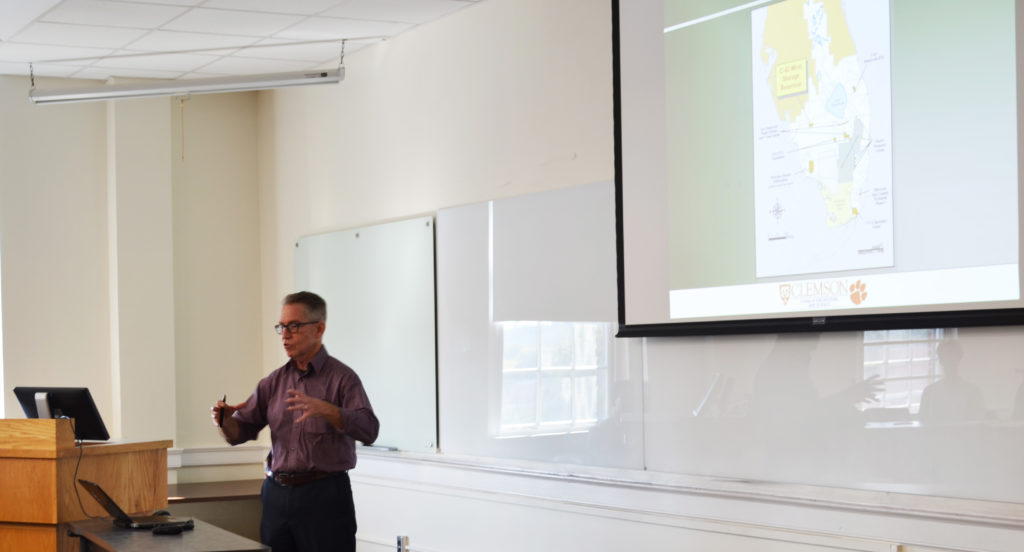
The project is owned by the South Florida Water Management, and is situated in the city of Labelle in Henry County, of which the purpose of construction is to normalize flows from Lake Okeechobee to the coastal estuary. It is an above ground storage reservoir of storage capacity of 170,000-acre foot and is classified as a high hazard potential facility whose failure would compromise the safety of nearby residents.
Geologic cross section from the top to the bottom of the dam comprises sand, limestone, clay and sand respectively. Two Test Cells are being constructed, of which the components of the construction process are Drainage Blanket, Chimney Drain, Embankment Fill and Soil-Bentonite Cutoff Wall Excavation. For the sake of seepage analysis and test cell monitoring, piezometers were installed, and toe drain sump and a weather station were constructed. For the slope stability and slope protection design, twenty-nine geotechnical sections were used yielding the following factors of safety: a) end of construction — F.S. = 1.3 b) steady seepage — F.S. = 1.5 and c) rapid drawdown — F.S = 1.4. Other design considerations that were discussed are embankment settlement, hydraulic structures through dam, Townsend canal pressure relief system, existing major canal crossings, and erosion of embankment slopes. The current status of the project is as follows: 1) Preload and Demolition — completed. 2) S-470 Pumping Station — almost complete. 3) S-470 Pumping Station — just underway, and 4) Earth Dam and Reservoir Structures — Final Design Review

